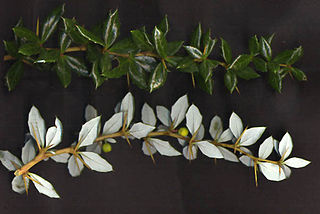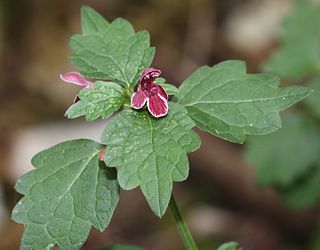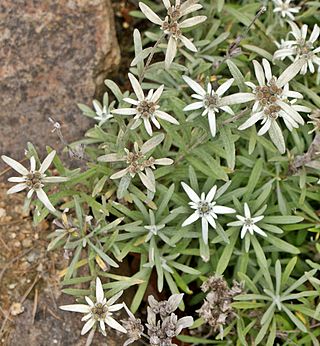
Zinnia is a genus of plants of the tribe Heliantheae within the family Asteraceae. They are native to scrub and dry grassland in an area stretching from the Southwestern United States to South America, with a centre of diversity in Mexico. Members of the genus are notable for their solitary long-stemmed 12 petal flowers that come in a variety of bright colors. The genus name honors the German scientist Johann Gottfried Zinn (1727–1759).

Sanvitalia ), the creeping zinnias, is a genus of flowering plants belonging to the family Asteraceae. They are native to mostly to Mexico, with a few species in Central America, South America, and the Southwestern United States.

Berberis verruculosa, the warty barberry or warted barberry, is an evergreen shrub in the family Berberidaceae. It ranges in size from 1–2 m, and is native to western China. It gets its common name from its "warty" stems, that have rounded, more or less identical, raised spots.
Heliotropium pannifolium, the Saint Helena heliotrope, is now extinct but was formerly a hairy-leaved small shrub in the family Boraginaceae. It grew to a height of up to 1 m. It was only seen once, by the explorer W. Burchell in Broad Gut, Saint Helena and has never been seen again. Human impact on the island of Saint Helena was severe and the Saint Helena heliotrope is one of several extinct plants from that island.
Scalesia retroflexa is a species of flowering plant in the family Asteraceae. It is found only in the Galápagos Islands of Ecuador. It is threatened by habitat loss.

Aristolochia westlandii is a species of plant in the family Aristolochiaceae. It is found in China and Hong Kong, in valley forests in Guangdong Province at an elevation of 300 to 800 metres. The leaves are long, narrow and pointed. The flowers are bent tubes from 10–15 centimetres (3.9–5.9 in) long that grow from the base of a leaf. They are yellow with purple veins and blotches.

Asarum maximum is a species of plant in the family Aristolochiaceae. It is endemic to China. The flowers have a distinct smell of mushrooms.
Polyscias crassa is a species of plant in the family Araliaceae. It is endemic to Seychelles. It is threatened by habitat loss.
Oreopanax sanderianus is a species of plant in the family Araliaceae. It is found in Guatemala, Honduras, and Mexico. It is threatened by habitat loss.
Saurauia oreophila is a species of flowering plant in the family Actinidiaceae. It is found in Guatemala and Mexico. It is threatened by habitat loss.
Saurauia scabrida is a species of flowering plant in the family Actinidiaceae. It is endemic to Mexico.

Miconia bicolor is a species flowering plant in the glory bush family, Melastomataceae, that is native to southern Florida in the United States and the Caribbean. Common names include Florida clover ash, Florida tetrazygia, and West Indian lilac.

Loxocalyx is a genus of plants in the family Lamiaceae, first described in 1891. It is native to China and Japan.

Heliopsis annua is a species of flowering plant in the family Asteraceae. It is widespread across much of northern and central Mexico from Chihuahua and Coahuila as far south as Puebla and Michoacán.
Heliopsis procumbens is a species of flowering plant in the family Asteraceae. It is native to central Mexico from Jalisco and Michoacán east to Veracruz. Its daisy-like flowers, which have a diameter of 2-3 inches and yellow-orange rays encircling brownish-yellow center cones, are characteristic of its typical 3–4-foot growth. Throughout the summer, flowers bloom on stiff stems covered in up to six-inch-long, ovate, toothed leaves.

Aloe cameronii is a species of flowering plant in the family Asphodelaceae. It is indigenous to Malawi and Zimbabwe.

Leontopodium sinense is a species of plant in the family Asteraceae. It is native to China.

Leontopodium stracheyi is a species of plant in the family Asteraceae. It is native to China, Bhutan, India and Nepal.
Ainsliaea elegans is a species of flowering plants in the family Asteraceae. It is found in China and Vietnam.
Anaxagorea crassipetala is a species of understory tree in the family Annonaceae. It is found frequently in the lowland rainforests of Costa Rica and Panama, but extends down to Peru.










